Advances in the Mitigation of Microbiologically Influenced Concrete Corrosion: A Snapshot
Abstract
1. Introduction
2. Microbially Influenced Concrete Corrosion
2.1. The Part Played by Microorganisms
2.1.1. Oil and Gas Industry
2.1.2. Cooling Water Systems
2.1.3. Civil Infrastructures
2.1.4. Sewer Systems
2.2. Strategies for MIC Mitigation in Concrete
2.2.1. Coatings and Linings
2.2.2. Biocides
2.2.3. Hybrid Concrete Mixtures
2.3. Current Approaches for Mitigation of MIC
2.3.1. Biological Competition
2.3.2. Secretion of Antibiotic Substances
2.3.3. Phagocytosis of Microorganisms
2.3.4. Inhibition of Microbial Attachment
3. Conclusions
Funding
Acknowledgments
Conflicts of Interest
References
- Noeiaghaei, T.; Mukherjee, A.; Dhami, N.; Chae, S.-R. Biogenic deterioration of concrete and its mitigation technologies. Constr. Build. Mater. 2017, 149, 575–586. [Google Scholar] [CrossRef]
- Li, X.; O’Moore, L.; Song, Y.; Bond, P.L.; Yuan, Z.; Wilkie, S.; Hanzic, L.; Jiang, G. The rapid chemically induced corrosion of concrete sewers at high H2S concentration. Water Res. 2019, 162, 95–104. [Google Scholar] [CrossRef] [PubMed]
- Fytianos, G.; Tziolas, E.; Papastergiadis, E.; Samaras, P. Least Cost Analysis for Biocorrosion Mitigation Strategies in Concrete Sewers. Sustainability 2020, 12, 4578. [Google Scholar] [CrossRef]
- Gutiérrez-Padilla, M.G.D.; Bielefeldt, A.; Ovtchinnikov, S.; Hernandez, M.; Silverstein, J. Biogenic sulfuric acid attack on different types of commercially produced concrete sewer pipes. Cem. Concr. Res. 2010, 40, 293–301. [Google Scholar] [CrossRef]
- Gu, J.-D.; Ford, T.E.; Berke, N.S.; Mitchell, R. Biodeterioration of concrete by the fungus Fusarium. Int. Biodeterior. Biodegrad. 1998, 41, 101–109. [Google Scholar] [CrossRef]
- Zhang, M.; Pan, L.; Liu, L.; Su, C.; Dou, L.; Su, Z.; He, Z. Phosphorus and Nitrogen Removal by a novel phosphate-accumulating organism, arthrobacter sp. hhep5 capable of heterotrophic nitrification-aerobic denitrification: Safety assessment, Removal characterization, mechanism exploration and wastewater treatment. Biores. Tech. 2020, 312, 123633. [Google Scholar] [CrossRef] [PubMed]
- Fonseca, A.J.; Pina, F.; Macedo, M.F.; Leal, N.; Romanowska-Deskins, A.; Laiz, L.; Gómez-Bolea, A.; Saiz-Jimenez, C. Anatase as an alternative application for preventing biodeterioration of mortars: Evaluation and comparison with other biocides. Int. Biodeterior. Biodegrad. 2010, 64, 388–396. [Google Scholar] [CrossRef]
- Alum, A.; Rashid, A.; Mobasher, B.; Abbaszadegan, M. Cement-based biocide coatings for controlling algal growth in water distribution canals. Cem. Concr. Compos. 2008, 30, 839–847. [Google Scholar] [CrossRef]
- El Gamal, M.M.; El-Dieb, A.S.; Mohamed, A.M.O.; El Sawy, K.M. Performance of modified sulfur concrete exposed to actual sewerage environment with variable temperature, humidity and gases. J. Build. Eng. 2017, 11, 1–8. [Google Scholar] [CrossRef]
- Zhou, J.; Yin, S.; Fu, Q.; Wang, Q.; Huang, Q.; Wang, J. Microbial-induced concrete corrosion under high-salt conditions: Microbial community composition and environmental multivariate association analysis. Int. Biodeterior. Biodegrad. 2021, 163, 105287. [Google Scholar] [CrossRef]
- Booth, G.H. Sulphur Bacteria in Relation to Corrosion. J. Appl. Bacteriol. 1964, 27, 174–181. [Google Scholar] [CrossRef]
- Grengg, C.; Mittermayr, F.; Ukrainczyk, N.; Koraimann, G.; Kienesberger, S.; Dietzel, M. Advances in concrete materials for sewer systems affected by microbial induced concrete corrosion: A review. Water Res. 2018, 134, 341–352. [Google Scholar] [CrossRef] [PubMed]
- US EPA. Process Design Manual for Sulfide Control in Sanitary Sewerage Systems No Title. 1974. Available online: http://cfpub.epa.gov/si/si_public_comments.cfm (accessed on 1 September 2024).
- O’connell, M.; McNally, C.; Richardson, M.G. Biochemical attack on concrete in wastewater applications: A state of the art review. Cem. Concr. Compos. 2010, 32, 479–485. [Google Scholar] [CrossRef]
- Gu, L.; Visintin, P.; Bennett, T. Evaluation of accelerated degradation test methods for cementitious composites subject to sulfuric acid attack; application to conventional and alkali-activated concretes. Cem. Concr. Compos. 2018, 87, 187–204. [Google Scholar] [CrossRef]
- Monteny, J.; Vincke, E.; Beeldens, A.; De Belie, N.; Taerwe, L.; Van Gemert, D.; Verstraete, W. Chemical, microbiological, and in situ test methods for biogenic sulfuric acid corrosion of concrete. Cem. Concr. Res. 2000, 30, 623–634. [Google Scholar] [CrossRef]
- House, M.; Weiss, W.J. Review of Microbially Induced Corrosion and Comments on Needs Related to Testing Procedures. In Proceedings of the 4th International Conference on the Durability of Concrete Structures, West Lafayette, IN, USA, 24–26 July 2014; pp. 94–103. [Google Scholar] [CrossRef]
- Gerengi, H. The Use of Dynamic Electrochemical Impedance Spectroscopy in Corrosion Inhibitor Studies. Prot. Met. Phys. Chem. Surf. 2018, 54, 536–540. [Google Scholar] [CrossRef]
- Wu, M.; Wang, T.; Wu, K.; Kan, L. Microbiologically induced corrosion of concrete in sewer structures: A review of the mechanisms and phenomena. Constr. Build. Mater. 2020, 239, 1–14. [Google Scholar] [CrossRef]
- Domingo, J.W.S.; Revetta, R.P.; Iker, B.; Gomez-Alvarez, V.; Garcia, J.; Sullivan, J.; Weast, J. Molecular survey of concrete sewer biofilm microbial communities. Biofouling 2011, 27, 993–1001. [Google Scholar] [CrossRef] [PubMed]
- Akpabio, E.J.; Ekott, E.J.; Akpan, M.E. Inhibition and Control of Microbiologically Influenced Corrosion in Oilfield Materials. Environ. Res. J. 2011, 5, 59–65. [Google Scholar] [CrossRef]
- Chen, G.; Zhang, M.; Zhao, J.; Meng, Z.; Zhang, J. Investigation of Ginkgo Biloba leave extracts as corrosion and oil field microorganism inhibitors. Chemistry Cent. J. 2013, 7, 1–7. [Google Scholar] [CrossRef] [PubMed]
- Beddoe, R.E.; Dorner, H.W. Modelling acid attack on concrete: Part I. The essential mechanisms. Cem. Concr. Res. 2005, 35, 2333–2339. [Google Scholar] [CrossRef]
- Pryfogle, P. Monitoring Biological Activity at Geothermal Power Plants; Idaho National Laboratory (INL): Idaho Falls, ID, USA, 2005. [Google Scholar] [CrossRef][Green Version]
- Brown, K.L.; Bacon, L.G. Pilot plant experiments at Wairakei Power Station. Geothermics 2009, 38, 64–71. [Google Scholar] [CrossRef]
- George, R.P.; Vishwakarma, V.; Samal, S.S.; Mudali, U.K. Current understanding and Future Approaches for Controlling Microbially Influenced Concrete Corrosion: A Review. Concr. Res. Lett. 2012, 3, 491–506. Available online: http://www.challengejournal.com/index.php/cjcrl/article/download/153/116 (accessed on 1 October 2024).
- Trejo, D.; De Figueiredo, P.; Sanchez, M.; Gonzalez, C.; Wei, S.; Li, L. Analysis and Assessment of Microbial Biofilm-Mediated Concrete Deterioration; Report No.: SWUTC/08/476660-00008-1; Southwest Region University Transportation Center: College Station, TX, USA, 2008. [Google Scholar]
- Okabe, S.; Odagiri, M.; Ito, T.; Satoh, H. Succession of Sulfur-Oxidizing Bacteria in the Microbial Community on Corroding Concrete in Sewer Systems. Appl. Environ. Microbiol. 2007, 73, 971–980. [Google Scholar] [CrossRef] [PubMed]
- Huang, S.-P.; Chen, T.-Y.; Chen, J.-S.; Wang, L.-T.; Huang, L.; Lin, S.-T.; Wei, C.-L.; Lin, S.; Wang, P.-L.; Chen, Y.-M.; et al. Dongshaea marina gen. nov., sp. nov., a facultatively anaerobic marine bacterium that ferments glucose with gas production. Int. J. Syst. Evol. Microbiol. 2019, 69, 3318–3325. [Google Scholar] [CrossRef] [PubMed]
- Gaylarde, C.C.; Ortega-Morales, B.O. Biodeterioration and Chemical Corrosion of Concrete in the Marine Environment: Too Complex for Prediction. Microorganisms 2023, 11, 2438. [Google Scholar] [CrossRef]
- Liu, H.; Cheng, Y.F. Mechanistic aspects of microbially influenced corrosion of X52 pipeline steel in a thin layer of soil solution containing sulphate-reducing bacteria under various gassing conditions. Corros. Sci. 2018, 133, 178–189. [Google Scholar] [CrossRef]
- Eriksen, K. Thaumasite attack on concrete at Marbjerg Waterworks. Cem. Concr. Compos. 2003, 25, 1147–1150. [Google Scholar] [CrossRef]
- Haile, T.; Nakhla, G.; Allouche, E.; Vaidya, S. Evaluation of the bactericidal characteristics of nano-copper oxide or functionalized zeolite coating for bio-corrosion control in concrete sewer pipes. Corros. Sci. 2010, 52, 45–53. [Google Scholar] [CrossRef]
- Wu, L.; Hu, C.; Liu, W. The Sustainability of Concrete in Sewer Tunnel—A Narrative Review of Acid Corrosion in the City of Edmonton, Canada. Sustainability 2018, 10, 517. [Google Scholar] [CrossRef]
- Satoh, H.; Odagiri, M.; Ito, T.; Okabe, S. Microbial community structures and in situ sulfate-reducing and sulfur-oxidizing activities in biofilms developed on mortar specimens in a corroded sewer system. Water Res. 2009, 43, 4729–4739. [Google Scholar] [CrossRef] [PubMed]
- Munyao, O.M.; Thiong’o, J.K.; Muthengia, J.W.; Mutitu, D.K.; Mwirichia, R.; Muriithi, G.; Marangu, J.M. Study on the effect of Thiobacillus intermedius bacteria on the physico-mechanical properties of mortars of ordinary portland cement. Heliyon 2020, 6, e03232. [Google Scholar] [CrossRef] [PubMed]
- Qin, S.; Liu, X.; Lu, M.; Li, D.; Feng, X.; Zhao, L. Acidithiobacillus ferrooxidans and mixed Acidophilic microbiota oxidation to remove sulphur impurity from iron concentrate. Biochem. Eng. J. 2022, 187, 108647. [Google Scholar] [CrossRef]
- Li, X.; Kappler, U.; Jiang, G.; Bond, P.L. The Ecology of Acidophilic Microorganisms in the Corroding Concrete Sewer Environment. Front. Microbiol. 2017, 8, 683. [Google Scholar] [CrossRef]
- Pagaling, E.; Yang, K.; Yan, T. Pyrosequencing reveals correlations between extremely acidophilic bacterial communities with hydrogen sulphide concentrations, pH and inert polymer coatings at concrete sewer crown surfaces. J. Appl. Microbiol. 2014, 117, 50–64. [Google Scholar] [CrossRef] [PubMed]
- Huber, B.; Hilbig, H.; Mago, M.M.; Drewes, J.E.; Müller, E. Comparative analysis of biogenic and chemical sulfuric acid attack on hardened cement paste using laser ablation-ICP-MS. Cem. Concr. Res. 2016, 87, 14–21. [Google Scholar] [CrossRef]
- Wells, T.; Melchers, R.E. Modelling concrete deterioration in sewers using theory and field observations. Cem. Concr. Res. 2015, 77, 82–96. [Google Scholar] [CrossRef]
- Pramanik, S.K.; Bhuiyan, M.; Robert, D.; Roychand, R.; Gao, L.; Cole, I.; Pramanik, B.K. Bio-corrosion in concrete sewer systems: Mechanisms and mitigation strategies. Sci. Total Environ. 2024, 921, 171231. [Google Scholar] [CrossRef] [PubMed]
- Berndt, M.L. Evaluation of coatings, mortars and mix design for protection of concrete against sulphur oxidising bacteria. Constr. Build. Mater. 2011, 25, 3893–3902. [Google Scholar] [CrossRef]
- Shundo, A.; Yamamoto, S.; Tanaka, K. Network Formation and Physical Properties of Epoxy Resins for Future Practical Applications. JACS Au 2022, 2, 1522–1542. [Google Scholar] [CrossRef] [PubMed]
- Almusallam, A.A.; Khan, F.M.; Dulaijan, S.U.; Al-Amoudi, O.S.B. Effectiveness of surface coatings in improving concrete durability. Cem. Concr. Compos. 2003, 25, 473–481. [Google Scholar] [CrossRef]
- Hewayde, E.H.; Nakhla, G.; Allouche, E.N.; Mohan, P.K. Beneficial impact of coatings on biological generation of sulfide in concrete sewer pipes. Struct. Infrastruct. Eng. 2007, 3, 267–277. [Google Scholar] [CrossRef]
- Antolín-Rodríguez, A.; Merino-Maldonado, D.; González-Domínguez, J.M.; Fernández-Raga, M.; Pozo, J.M.M.-D.; García-González, J.; Juan-Valdés, A. Performance of graphene oxide as a water-repellent coating nanomaterial to extend the service life of concrete structures. Heliyon 2024, 10, e23969. [Google Scholar] [CrossRef] [PubMed]
- Dorado, F.; Toledo, L.; de la Osa, A.R.; Esteban-Arranz, A.; Sacristan, J.; Pellegrin, B.; Steck, J.; Sanchez-Silva, L. Adhesion enhancement and protection of concrete against aggressive environment using graphite-Fe2O3 modified epoxy coating. Constr. Build. Mater. 2023, 379, 131179. [Google Scholar] [CrossRef]
- Lishchynskyi, O.; Shymborska, Y.; Stetsyshyn, Y.; Raczkowska, J.; Skirtach, A.G.; Peretiatko, T.; Budkowski, A. Passive antifouling and active self-disinfecting antiviral surfaces. Chem. Eng. J. 2022, 446, 137048. [Google Scholar] [CrossRef]
- Ślosarczyk, A.; Klapiszewska, I.; Skowrońska, D.; Janczarek, M.; Jesionowski, T.; Klapiszewski, Ł. A comprehensive review of building materials modified with metal and metal oxide nanoparticles against microbial multiplication and growth. Chem. Eng. J. 2023, 466, 143276. [Google Scholar] [CrossRef]
- Shkodenko, L.; Kassirov, I.; Koshel, E. Metal Oxide Nanoparticles Against Bacterial Biofilms: Perspectives and Limitations. Microorganisms 2020, 8, 1545. [Google Scholar] [CrossRef]
- Kasi, G.; Gnanasekar, S.; Zhang, K.; Kang, E.T.; Xu, L.Q. Polyurethane-based composites with promising antibacterial properties. J. Appl. Polym. Sci. 2022, 139, 52181. [Google Scholar] [CrossRef]
- Dhaliwal, G.S.; Anandan, S.; Bose, M.; Chandrashekhara, K.; Nam, P. Effects of surfactants on mechanical and thermal properties of soy-based polyurethane foams. J. Cell. Plast. 2020, 56, 611–629. [Google Scholar] [CrossRef]
- Kausar, A. Polyurethane nanocomposite coatings: State of the art and perspectives. Polym. Int. 2018, 67, 1470–1477. [Google Scholar] [CrossRef]
- Vipulanandan, C.; Liu, J. Performance of polyurethane-coated concrete in sewer environment. Cem. Concr. Res. 2005, 35, 1754–1763. [Google Scholar] [CrossRef]
- Skovhus, T.L.; Enning, D.; Lee, J. Microbiologically Influenced Corrosion in the Upstream Oil and Gas Industry; CRC Press: Boca Raton, FL, USA, 2017. [Google Scholar] [CrossRef]
- Magot, M. Microbiology of Oil Fields. In Petroleum Microbiology; Ollivier, B., Magot, M., Eds.; ASM Press: Washington, DC, USA, 2014; pp. i–xi. [Google Scholar] [CrossRef]
- Wang, T.; Wu, K.; Kan, L.; Wu, M. Current understanding on microbiologically induced corrosion of concrete in sewer structures: A review of the evaluation methods and mitigation measures. Constr. Build. Mater. 2020, 247, 118539. [Google Scholar] [CrossRef]
- Kalajahi, S.T.; Misra, A.; Koerdt, A. Nanotechnology to mitigate microbiologically influenced corrosion (MIC). Front. Nanotechnol. 2024, 6, 1340352. [Google Scholar] [CrossRef]
- Skovhus, T.L.; Eckert, R.B.; Rodrigues, E. Management and control of microbiologically influenced corrosion (MIC) in the oil and gas industry—Overview and a North Sea case study. J. Biotechnol. 2017, 256, 31–45. [Google Scholar] [CrossRef] [PubMed]
- Wu, T.; Xu, J.; Yan, M.; Sun, C.; Yu, C.; Ke, W. Synergistic effect of sulfate-reducing bacteria and elastic stress on corrosion of X80 steel in soil solution. Corros. Sci. 2014, 83, 38–47. [Google Scholar] [CrossRef]
- Lavanya, M. A Brief Insight into Microbial Corrosion and its Mitigation with Eco-friendly Inhibitors. J. Bio. Tribocorros. 2021, 7, 1–9. [Google Scholar] [CrossRef]
- Graziani, L.; Quagliarini, E.; Osimani, A.; Aquilanti, L.; Clementi, F.; D’Orazio, M. The influence of clay brick substratum on the inhibitory efficiency of TiO2 nanocoating against biofouling. Build. Environ. 2014, 82, 128–134. [Google Scholar] [CrossRef]
- Jia, R.; Unsal, T.; Xu, D.; Lekbach, Y.; Gu, T. Microbiologically influenced corrosion and current mitigation strategies: A state of the art review. Int. Biodeterior. Biodegrad. 2019, 137, 42–58. [Google Scholar] [CrossRef]
- Elumalai, P.; Parthipan, P.; Narenkumar, J.; Sarankumar, R.K.; Karthikeyan, O.P.; Rajasekar, A. Influence of Thermophilic Bacteria on Corrosion of Carbon Steel in Hyper Chloride Environment. Int. J. Environ. Res. 2017, 11, 339–347. [Google Scholar] [CrossRef]
- Jordan, S.L.P.; Russo, M.R.; Blessing, R.L.; Theis, A.B. Inactıvatıon of glutaraldehyde by reactıon wıth sodıum bısulfıte. J. Toxicol. Environ. Health A 1996, 47, 299–309. [Google Scholar] [CrossRef]
- Ali, K.; Qureshi, M.I.; Saleem, S.; Khan, S.U. Effect of waste electronic plastic and silica fume on mechanical properties and thermal performance of concrete. Constr. Build. Mater. 2021, 285, 122952. [Google Scholar] [CrossRef]
- Araghi, H.J.; Nikbin, I.M.; Reskati, S.R.; Rahmani, E.; Allahyari, H. An experimental investigation on the erosion resistance of concrete containing various PET particles percentages against sulfuric acid attack. Constr. Build. Mater. 2015, 77, 461–471. [Google Scholar] [CrossRef]
- Liu, T.; Nafees, A.; Javed, M.F.; Aslam, F.; Alabduljabbar, H.; Xiong, J.J.; Khan, M.I.; Malik, M.Y. Comparative study of mechanical properties between irradiated and regular plastic waste as a replacement of cement and fine aggregate for manufacturing of green concrete. Ain Shams Eng. J. 2022, 13, 101563. [Google Scholar] [CrossRef]
- Olofinnade, O.; Chandra, S.; Chakraborty, P. Recycling of high impact polystyrene and low-density polyethylene plastic wastes in lightweight based concrete for sustainable construction. Mater. Today Proc. 2021, 38, 2151–2156. [Google Scholar] [CrossRef]
- Harihanandh, M.; Karthik, P. Feasibility study of recycled plastic waste as fine aggregates in concrete. Mater. Today Proc. 2022, 52, 1807–1811. [Google Scholar] [CrossRef]
- Islam, M.J.; Shahjalal, M.; Haque, N.M.A. Mechanical and durability properties of concrete with recycled polypropylene waste plastic as a partial replacement of coarse aggregate. J. Build. Eng. 2022, 54, 104597. [Google Scholar] [CrossRef]
- Hamada, H.M.; Al-Attar, A.; Abed, F.; Beddu, S.; Humada, A.M.; Majdi, A.; Yousif, S.T.; Thomas, B.S. Enhancing sustainability in concrete construction: A comprehensive review of plastic waste as an aggregate material. Sustain. Mater. Technol. 2024, 40, e00877. [Google Scholar] [CrossRef]
- EMEA. Corrosion and Mitigating it with CPVC-Lubrizol. 2021. Available online: https://www.lubrizol.com/Engineered-Materials/EMEA/Blog/2021/05/Corrosion-and-Mitigating-it-with-CPVC (accessed on 9 May 2024).
- Wang, J.; Du, M.; Li, G.; Shi, P. Research progress on microbiological inhibition of corrosion: A review. J. Clean. Prod. 2022, 373, 133658. [Google Scholar] [CrossRef]
- Son, H.M.; Kim, H.Y.; Park, S.M.; Lee, H.K. Ureolytic/Non-ureolytic bacteria co-cultured self-healing agent for cementitious materials crack repair. Materials 2018, 11, 782. [Google Scholar] [CrossRef] [PubMed]
- Javeed, Y.; Goh, Y.; Mo, K.H.; Yap, S.P.; Fen, L.B. Microbial self-healing in concrete: A comprehensive exploration of bacterial viability, implementation techniques, and mechanical properties. J. Mater. Res. Technol. 2024, 29, 2376–2395. [Google Scholar] [CrossRef]
- Castro-Alonso, M.J.; Montañez-Hernandez, L.E.; Sanchez-Muñoz, M.A.; Franco, M.R.M.; Narayanasamy, R.; Balagurusamy, N. Microbially induced calcium carbonate precipitation (MICP) and its potential in bioconcrete: Microbiological and molecular concepts. Front. Mater. 2019, 6, 126. [Google Scholar] [CrossRef]
- Jonkers, H.M.; Thijssen, A.; Muyzer, G.; Copuroglu, O.; Schlangen, E. Application of bacteria as self-healing agent for the development of sustainable concrete. Ecol. Eng. 2010, 36, 230–235. [Google Scholar] [CrossRef]
- Min, J.; Son, Y.; Jang, I.; Yi, C.; Park, W. Managing two simultaneous issues in concrete repair: Healing microcracks and controlling pathogens. Constr. Build. Mater. 2024, 416, 135125. [Google Scholar] [CrossRef]
- Xu, J.; Wang, X.; Yao, W.; Chen, Q.; Zhu, H.; Shah, S.P. Understanding the formation and structure of bio-mineralization for self-healing of marine concrete: An experimental and thermodynamic approach. Cem. Concr. Compos. 2024, 145, 105369. [Google Scholar] [CrossRef]
- Fan, F.; Zhang, B.; Liu, J.; Cai, Q.; Lin, W.; Chen, B. Towards sulfide removal and sulfate reducing bacteria inhibition: Function of biosurfactants produced by indigenous isolated nitrate reducing bacteria. Chemosphere 2020, 238, 124655. [Google Scholar] [CrossRef]
- Hubert, C.; Voordouw, G. Oil Field Souring Control by Nitrate-Reducing Sulfurospirillum spp. That Outcompete Sulfate-Reducing Bacteria for Organic Electron Donors. Appl. Environ. Microbiol. 2007, 73, 2644–2652. [Google Scholar] [CrossRef] [PubMed]
- Fida, T.T.; Chen, C.; Okpala, G.; Voordouw, G. Implications of Limited Thermophilicity of Nitrite Reduction for Control of Sulfide Production in Oil Reservoirs. Appl. Environ. Microbiol. 2016, 82, 4190–4199. [Google Scholar] [CrossRef] [PubMed]
- Korenblum, E.; der Weid, I.; Santos, A.L.S.; Rosado, A.S.; Sebastian, G.V.; Coutinho, C.M.L.M.; Magalhaes, F.C.M.; Paiva, M.M.; Seldin, L. Production of antimicrobial substances by Bacillus subtilis LFE-1, B. firmus H2O-1 and B. licheniformis T6-5 isolated from an oil reservoir in Brazil. J. Appl. Microbiol. 2005, 98, 667–675. [Google Scholar] [CrossRef] [PubMed]
- Korenblum, E.; Sebastián, G.V.; Paiva, M.M.; Coutinho, C.M.L.M.; Magalhães, F.C.M.; Peyton, B.M.; Seldin, L. Action of antimicrobial substances produced by different oil reservoir Bacillus strains against biofilm formation. Appl. Microbiol. Biotechnol. 2008, 79, 97–103. [Google Scholar] [CrossRef] [PubMed]
- Qiu, L.; Mao, Y.; Gong, A.; Zhang, W.; Cao, Y.; Tong, L. Inhibition effect of Bdellovibrio bacteriovorus on the corrosion of X70 pipeline steel induced by sulfate-reducing bacteria. Anti-Corros. Methods Mater. 2016, 63, 269–274. [Google Scholar] [CrossRef]
- Jakobsen, T.H.; Bjarnsholt, T.; Jensen, P.Ø.; Givskov, M.; Høiby, N. Targeting quorum sensing in Pseudomonas aeruginosa biofilms: Current and emerging inhibitors. Future Microbiol. 2013, 8, 901–921. [Google Scholar] [CrossRef]
- Gökalsın, B.; Aksoydan, B.; Erman, B.; Sesal, N.C. Reducing Virulence and Biofilm of Pseudomonas aeruginosa by Potential Quorum Sensing Inhibitor Carotenoid: Zeaxanthin. Microb. Ecol. 2017, 74, 466–473. [Google Scholar] [CrossRef] [PubMed]
- Kim, S.; Thiessen, P.A.; Bolton, E.E.; Chen, J.; Fu, G.; Gindulyte, A.; Han, L.; He, J.; He, S.; Shoemaker, B.A.; et al. PubChem substance and compound databases. Nucleic Acids Res. 2016, 44, D1202–D1213. [Google Scholar] [CrossRef] [PubMed]
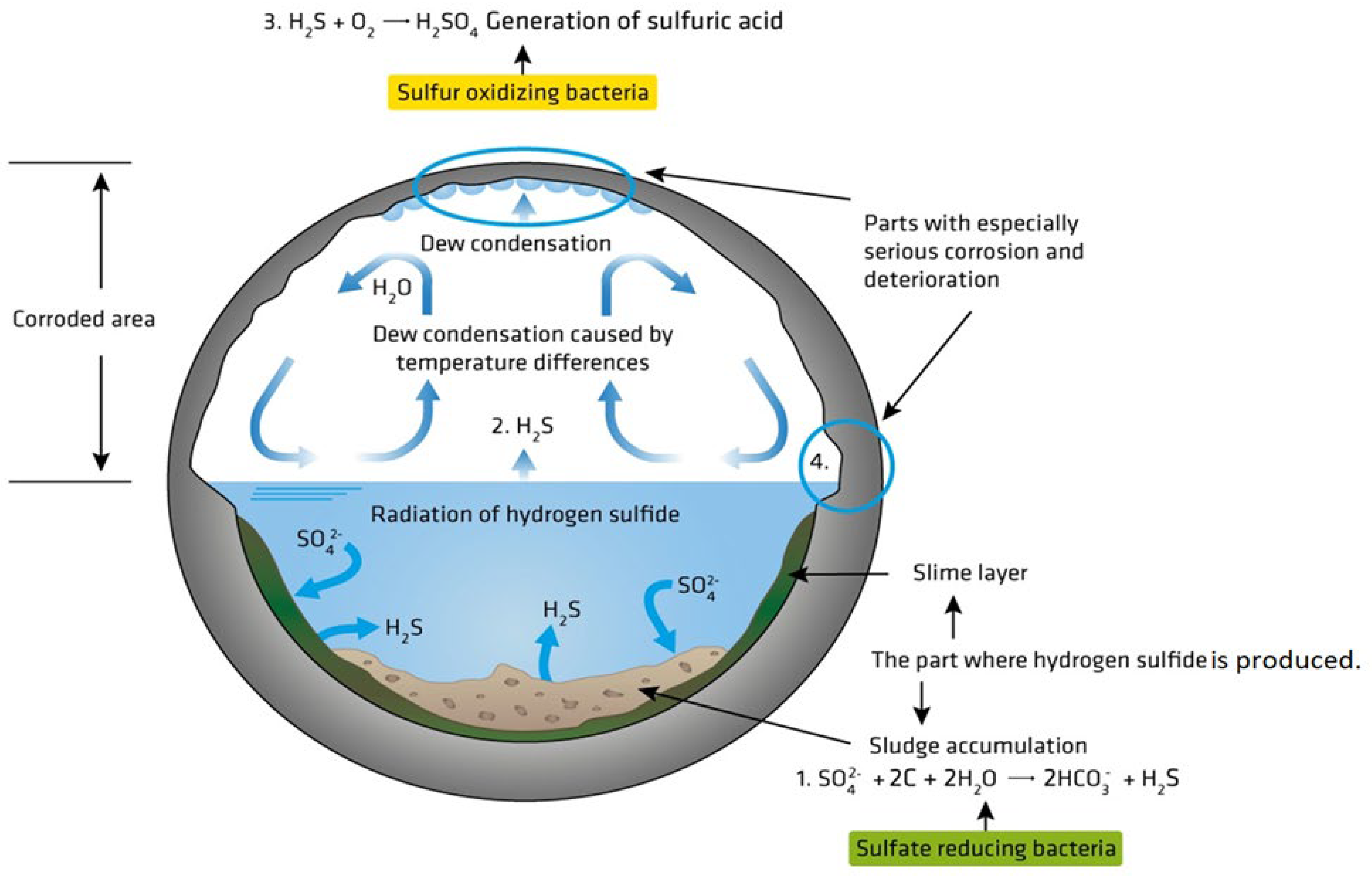
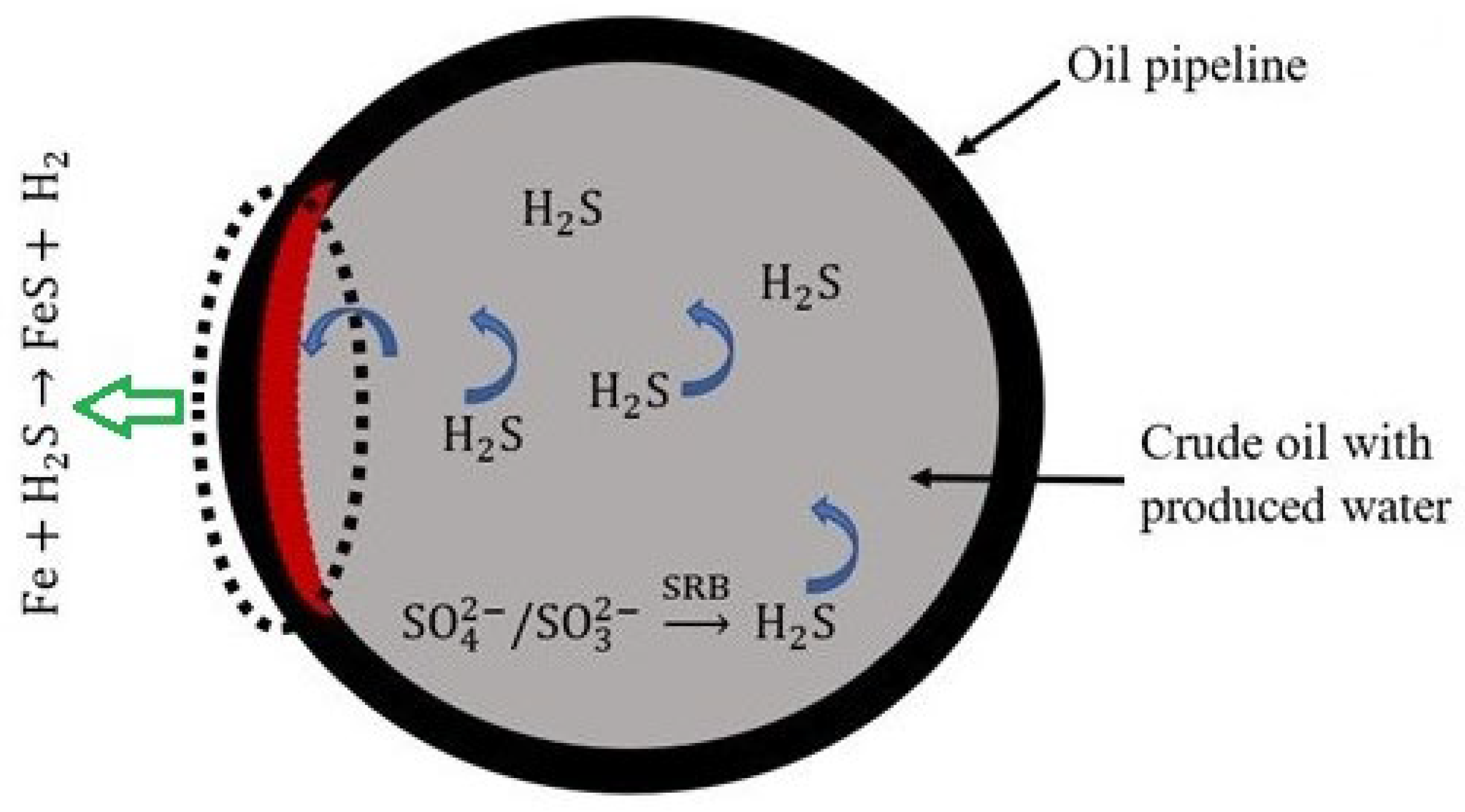
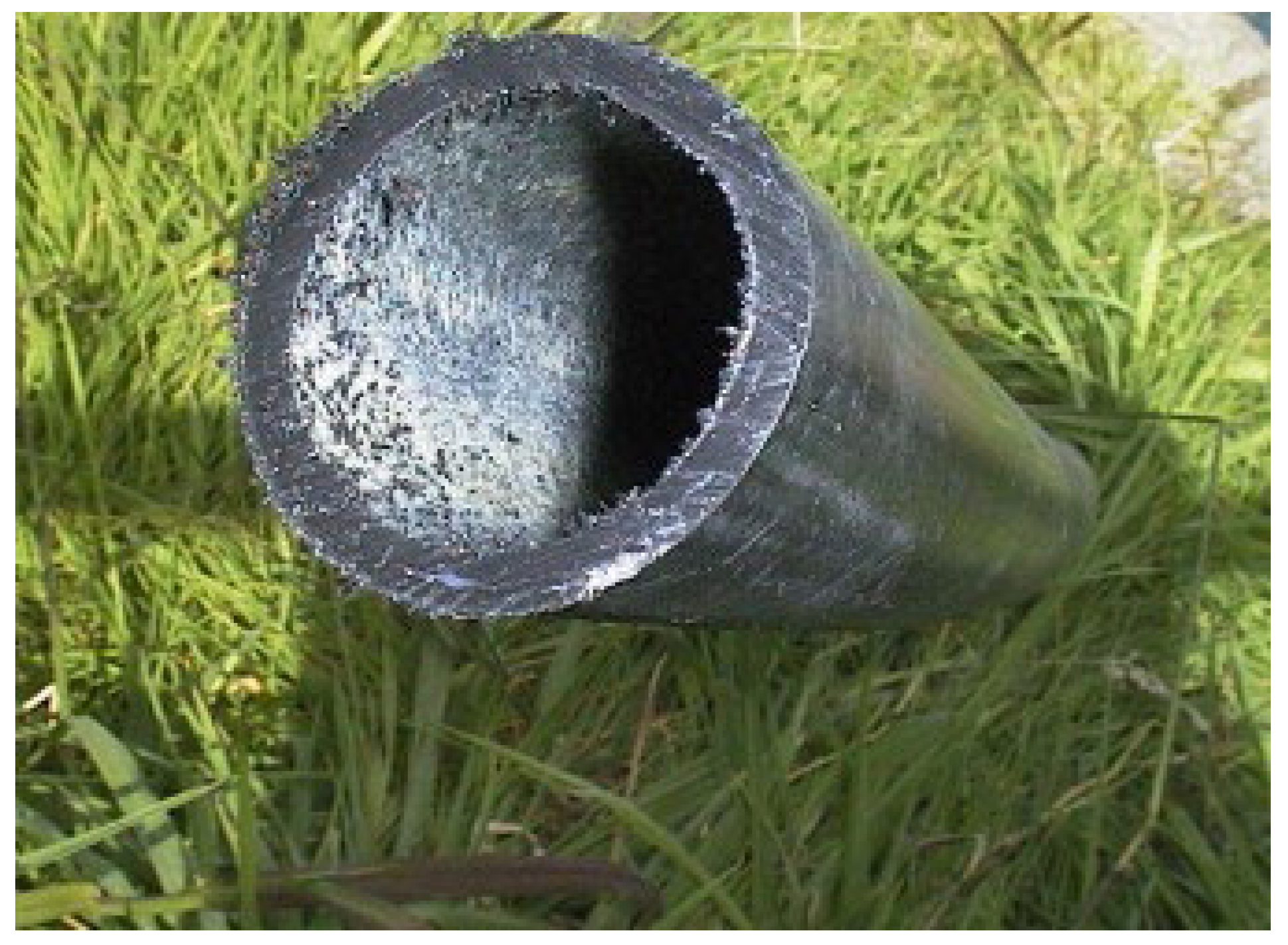
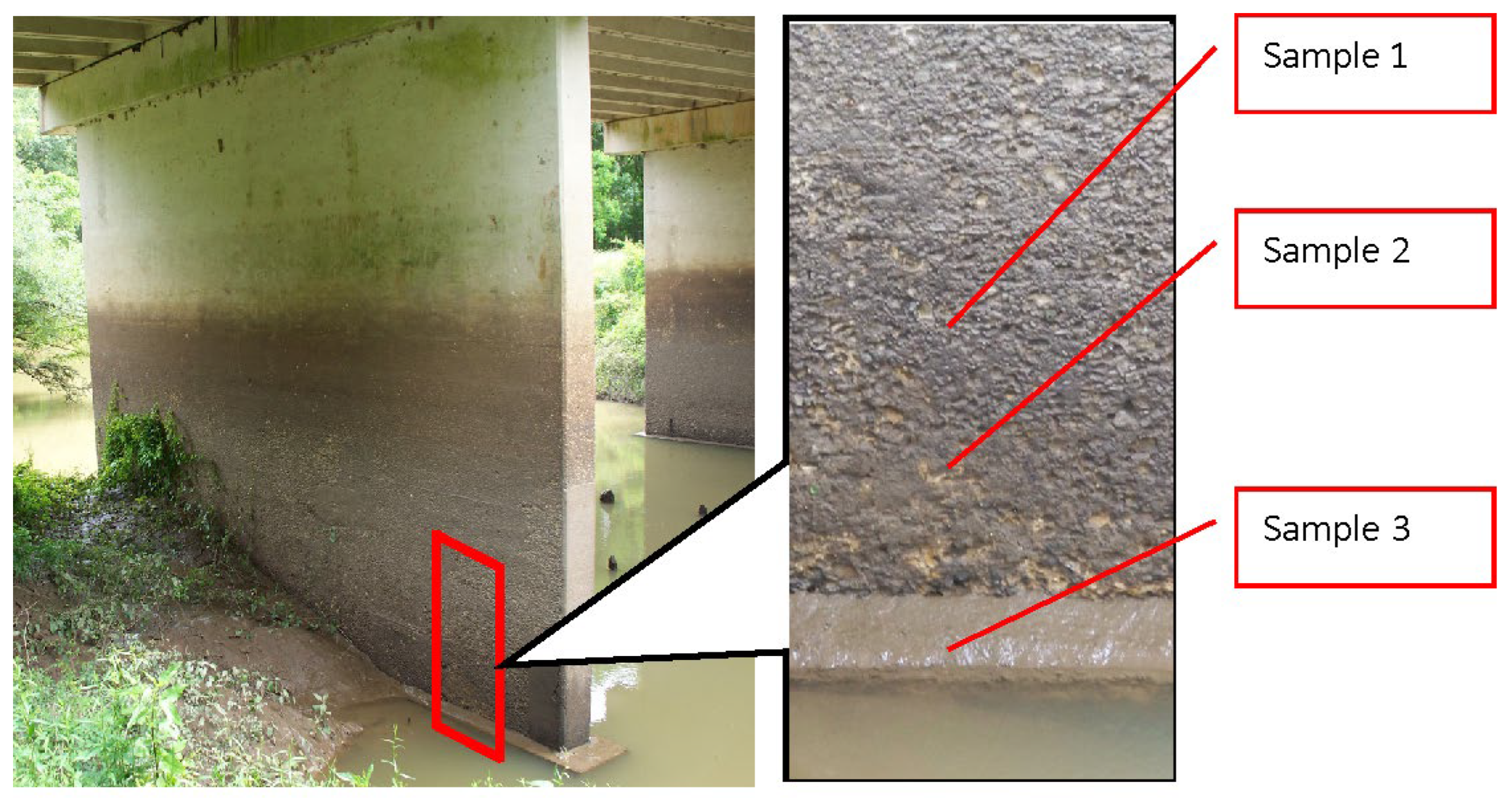

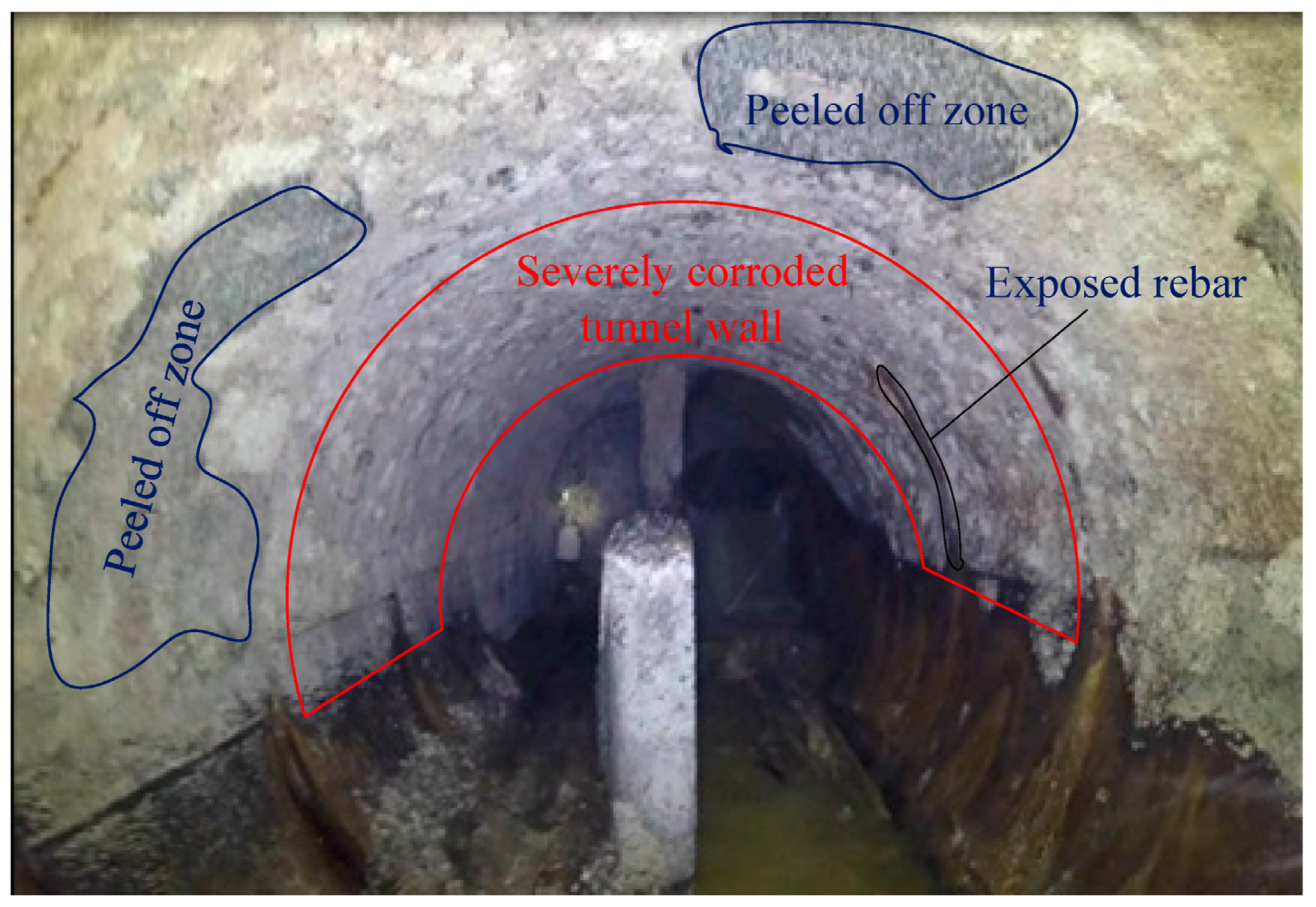
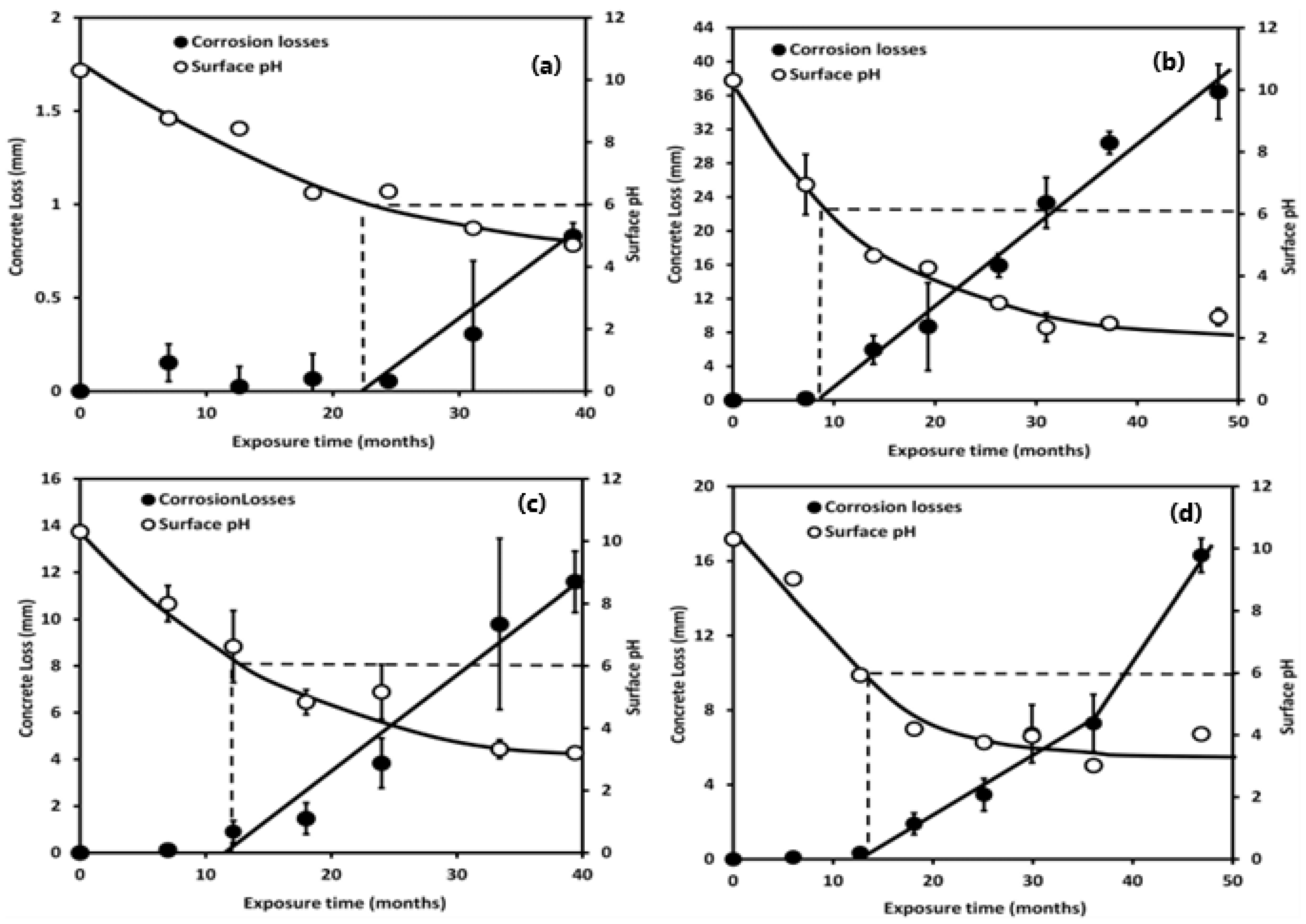
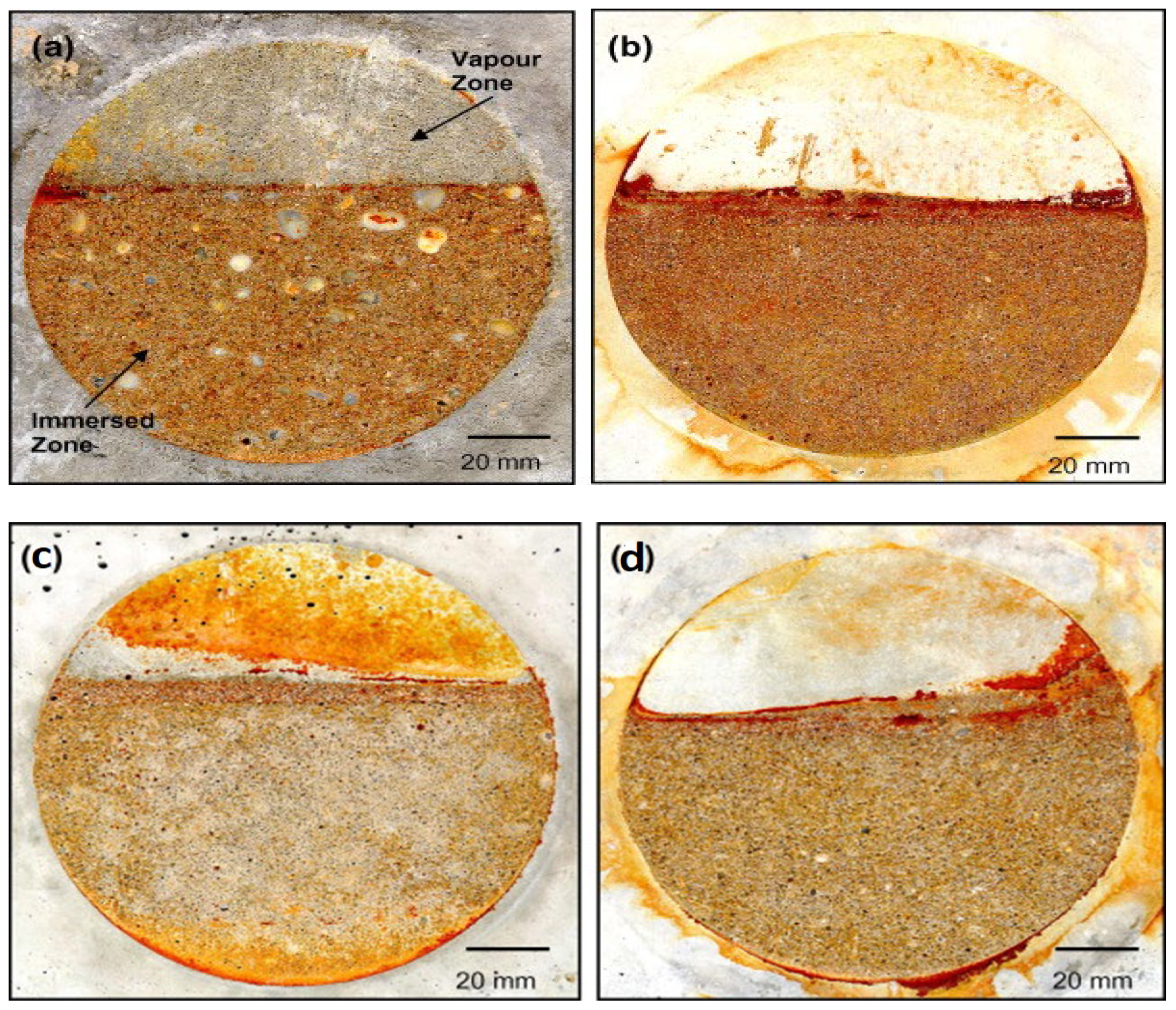

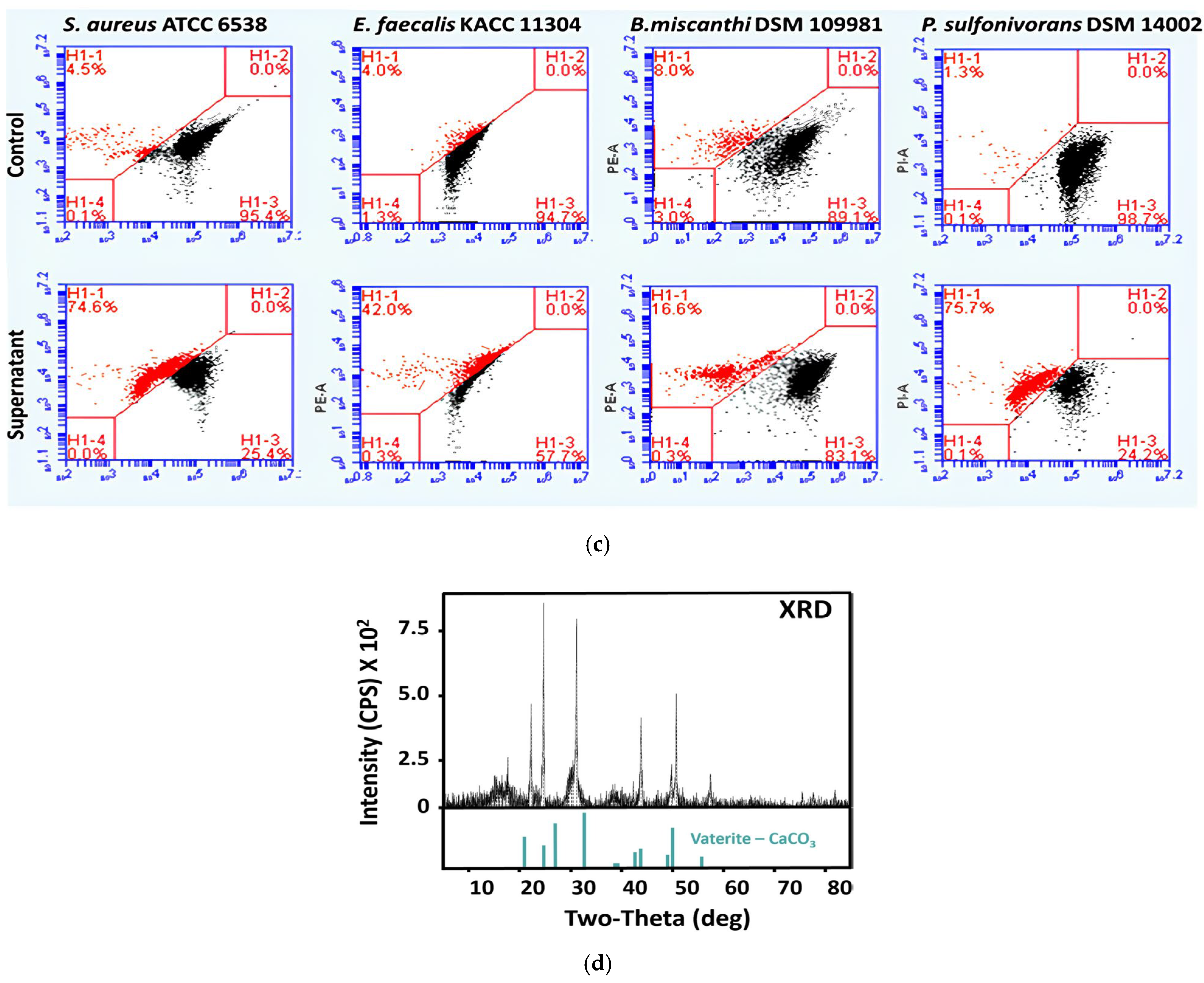
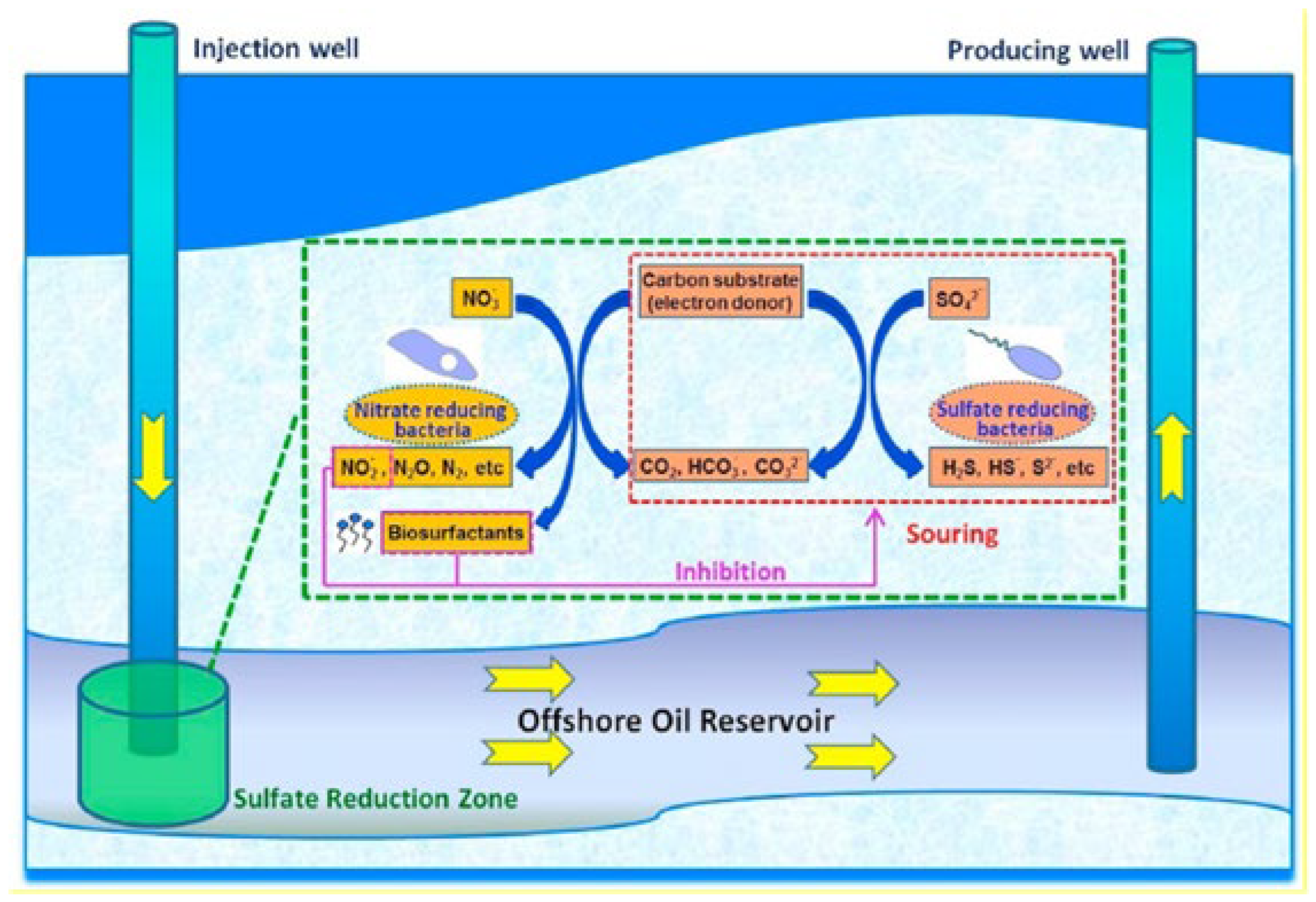
Disclaimer/Publisher’s Note: The statements, opinions and data contained in all publications are solely those of the individual author(s) and contributor(s) and not of MDPI and/or the editor(s). MDPI and/or the editor(s) disclaim responsibility for any injury to people or property resulting from any ideas, methods, instructions or products referred to in the content. |
© 2024 by the authors. Licensee MDPI, Basel, Switzerland. This article is an open access article distributed under the terms and conditions of the Creative Commons Attribution (CC BY) license (https://creativecommons.org/licenses/by/4.0/).
Share and Cite
Gerengi, H.; Kaya, E.; Solomon, M.M.; Snape, M.; Koerdt, A. Advances in the Mitigation of Microbiologically Influenced Concrete Corrosion: A Snapshot. Materials 2024, 17, 5846. https://doi.org/10.3390/ma17235846
Gerengi H, Kaya E, Solomon MM, Snape M, Koerdt A. Advances in the Mitigation of Microbiologically Influenced Concrete Corrosion: A Snapshot. Materials. 2024; 17(23):5846. https://doi.org/10.3390/ma17235846
Chicago/Turabian StyleGerengi, Husnu, Ertugrul Kaya, Moses M. Solomon, Matthew Snape, and Andrea Koerdt. 2024. "Advances in the Mitigation of Microbiologically Influenced Concrete Corrosion: A Snapshot" Materials 17, no. 23: 5846. https://doi.org/10.3390/ma17235846
APA StyleGerengi, H., Kaya, E., Solomon, M. M., Snape, M., & Koerdt, A. (2024). Advances in the Mitigation of Microbiologically Influenced Concrete Corrosion: A Snapshot. Materials, 17(23), 5846. https://doi.org/10.3390/ma17235846







